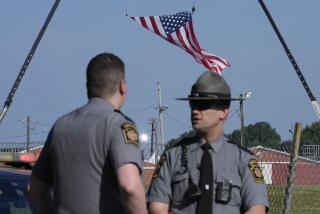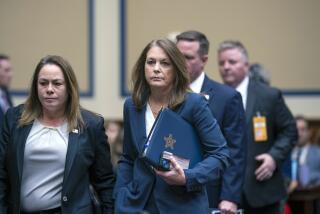Witnesses Fail to Offer Clear Sniper Portrait
- Share via
ROCKVILLE, Md. -- Distance, night’s dimness and a rifle blast’s chaotic aftermath hindered eyewitnesses to the latest slaying by the shooter who has terrorized the Washington area for two weeks, limiting their ability to provide police with a clear portrait of the gunman in action, officials said Wednesday.
Investigators were encouraged by the first close-range witness accounts of a male gunman who was seen targeting FBI analyst Linda Franklin, 47, moments before she was slain by a single gunshot Monday night outside a Home Depot in Falls Church, Va. But three of the accounts turned out to be thin and at odds, officials said Wednesday, preventing law-enforcement artists from preparing a composite drawing of a dark-skinned man reported as a possible suspect.
“There are a couple of people who believe they saw a man shoot,” said Montgomery County Police Capt. Nancy Demme. But “unfortunately distance and darkness, and perhaps adrenaline, have made them unable to give a clear composite.”
The frailty of human perception that undercuts the probe’s newest leads is a familiar menace to homicide detectives. In the careening moments that follow the report of a gunshot, witnesses often glimpse only shards of reality, filling in gaps with misinformation. Their accounts can be limited and tainted by confusion, fear, news reports and stories told by other witnesses at the scene.
“One shot, the body falls and people react to it,” said University of Delaware criminologist Carl B. Klockars. “There are a lot of things going on quickly. People are looking at different aspects of commotion, and they’re likely to be distracted.”
One witness interviewed minutes after the shooting Monday reportedly told police that he saw a man aiming a rifle at Franklin, who was putting packages in her car, from about 40 yards away just before she fell. Officials said Wednesday that according to the witness, the gunman was wielding an AK-74 semiautomatic rifle, a variant of the Kalashnikov AK-47 that can be adapted to fire .223-caliber rounds.
But the eyewitness was unable to provide detailed facial characteristics of the gunman, and his account conflicted with several other descriptions of the suspect, Demme said. “Each witness firmly believes what he saw,” she said.
Nine people have been killed and two wounded in the last two weeks as the shooter has terrorized a sprawling suburban landscape of commercial streets, chain-store shopping malls, gas stations and even a placid middle school campus. The killer has grown progressively bolder, opening fire last week on a victim within sight of a Virginia state trooper, then choosing the parking lot of a Home Depot crowded with shoppers to stalk and fatally wound his latest victim.
“The killer’s picking a time and place where he feels comfortable,” said one task force investigator. The choice of a Home Depot parking lot jammed with cars “gave him cover. There were a lot of cars moving around. The witnesses didn’t know necessarily what to look for. So far, we’ve got the best we can hope for.”
Police are often hesitant to issue composite sketches without “strong corroborating” accounts, said Portland, Maine, Police Chief Michael Chitwood, who became a Philadelphia police legend during eight years as a homicide investigator there. “Once you put that out, people are going to focus and leads will start pouring in. If the composite’s not right, the whole investigation can go off in the wrong direction.”
Officials close to the murder probe said investigators were initially energized by several of the new leads given by witnesses in Falls Church on Monday. Fairfax County Police Chief Thomas Manger said hours after the shooting that he was “confident” the witness interviews gleaned by investigators “would lead to an arrest.”
On Wednesday, Fairfax County detectives again interviewed several witnesses. Among them was Washington construction worker Robert Young, who said he heard a muffled gunshot and then saw a white van driven by a dark-skinned man who appeared to be of Middle Eastern descent.
“I got a good look at the guy,” Young said, adding that the driver “seemed to be excessively irritated because he couldn’t pull into my lane. I thought this fool was going to want to get out of the van and duke or something. But he didn’t. He kept on going.”
The accounts of an “olive-skinned” suspect spurred police to briefly detain several dark-complexioned men along U.S. 50 near the Seven Corners Shopping Center.
But concern about the reliability of those accounts led Demme on Wednesday to pointedly urge citizens who might get caught up in the next shooting scene to “seek cover,” then “commit what you saw to memory, have a pen available on your person and if paper is not available, write it on your hand.”
Demme also cautioned that individual accounts might even be “contaminated” by other witnesses if crime scene observers are not kept apart.
Witnesses at the scene of Franklin’s murder said Fairfax County officers appeared to move quickly to ensure there was no “leakage” of their accounts. Joy Zucker, a freelance television producer who arrived at the Home Depot about five minutes after the shooting, said that at least four witnesses had already been whisked away by police for interviews. Police took care, she said, to keep those witnesses away from a larger crowd inside the store.
“It was impressive how they managed to get them away from the frenzy so quickly and quietly without anyone noticing,” Zucker said.
But Zucker said another dozen witnesses who also had views of the crime scene waited for long minutes outside the store entrance until police took them aside, one by one, for questioning. Remarkably, she said, “there was just a stunned silence. These people were not comparing notes on what they saw. They were still taking in the shock of it all.”
Kathy Pezdek, a professor of psychology at Claremont Graduate University and an expert on witness behavior, said that police need to keep witnesses from mingling.
“It’s clearly not a good strategy,” she said of allowing witnesses to talk with one another. “The witnesses can shape each other’s memory and influence each other.”
That message was delivered Friday by task force officials to local police chiefs from dozens of departments, from Baltimore to Richmond, Va. During a closed meeting in a University of Maryland conference room, FBI agents and other senior task force officials warned the gathered police officials that they needed to adhere to “standardized” plans to deal with witnesses.
The officials were told bluntly that they had to identify, and quickly segregate, the witnesses.
“We don’t want to lose witness statements because of taint from other witnesses,” a task force official said. The police departments affected by the killings, which now include six separate jurisdictions, have “done a pretty good job” in preventing witness contamination, the official added.
*
Times staff writers Jonathan Peterson and Eddy Ramirez contributed to this report.
More to Read
Sign up for Essential California
The most important California stories and recommendations in your inbox every morning.
You may occasionally receive promotional content from the Los Angeles Times.













